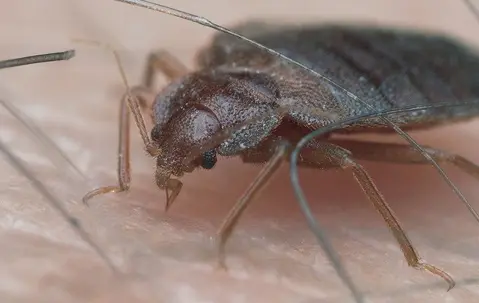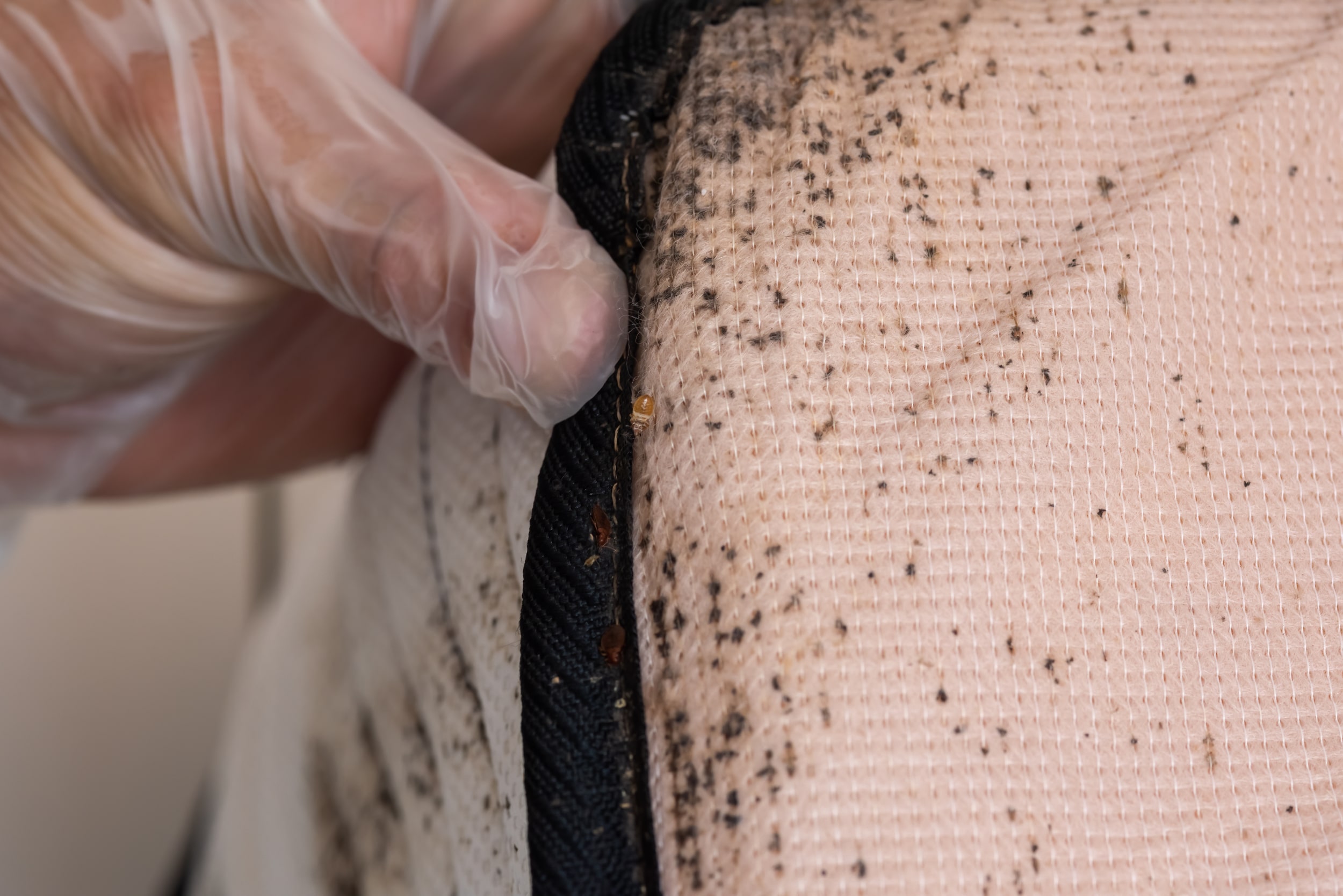Florida’s subtropical environment featuring warm temperatures, moderate winters, and ample humidity allows bed bugs to remain active, feed, and reproduce nearly nonstop. In Port Orange, a flourishing coastal community on Florida’s Atlantic side, these resilient insects readily find their way into single-family homes, short-term rentals, or commercial establishments via suitcases, secondhand furniture, or occupant belongings. By the time occupants notice red bite marks or small black specks on bedding, bed bugs may already occupy mattress seams, furniture folds, and gaps around baseboards. This page explains why bed bugs thrive in Florida, how to spot a likely infestation, and why enlisting a professional bed bug exterminator for bed bug treatments in Florida is the most effective route to regaining a bite-free, relaxing interior.
Whether you oversee a property in Port Orange or service rental units also catering to Edgewater and New Smyrna Beach, uncovering bed bugs early and implementing specialized, multi-phase solutions protects residents from escalating outbreaks, disrupted sleep, and do-it-yourself measures that commonly miss unhatched eggs or newly hatched nymphs lodged in deep seams or hidden cracks.
Why Bed Bugs Flourish in Florida
Mild Winter Temperatures
In colder regions, freezing winters naturally shrink bed bug populations or force them dormant for extended months. Florida’s gentle cold season seldom hits freezing, letting bed bugs steadily feed and lay eggs indoors across every season. Climate-controlled interiors (roughly 65–85°F) remove seasonal slowdowns, allowing each bed bug stage egg, nymph, adult to progress unless occupant or manager interventions disrupt them.
Frequent Movement of People & Goods
Florida’s tourism, relocations, and thriving secondhand trade generate continuous luggage or furniture transfers as primary bed bug carriers. In Port Orange, occupant turnovers or short-stay guests can unknowingly introduce bed bugs if occupant or housekeeping inspections are minimal. A single egg-bearing couch or suitcase can spark a widespread infestation quickly if not detected early.
Multiple Hiding Spots
Bed bugs compress to hide in mattress seams, box spring edges, upholstery folds, or narrow baseboard gaps. Largely nocturnal, they remain unnoticed by day, biting occupants at night. People often only realize they have bed bugs once they see unexplained bites or black specks on sheets after bed bugs possibly occupy multiple room corners.
Rapid Reproduction
A single female bed bug can deposit numerous eggs daily, each hatching within 2 weeks under Florida’s mild winter climate. Nymphs reach adulthood in about a month, laying more eggs if occupant or professional steps don’t halt them. A tiny infiltration swiftly expands into a multi-room or multi-floor infestation if occupant or manager vigilance is lacking.

Signs of a Bed Bug Infestation
- Nighttime Bites or Red Marks
- Commonly on arms, legs, or neck uncovered skin while sleeping in small, itchy bumps often aligned in rows or clusters.
- Some individuals display prominent welts; others barely notice, slowing occupant perception of bed bug presence.
- Commonly on arms, legs, or neck uncovered skin while sleeping in small, itchy bumps often aligned in rows or clusters.
- Black Dots or Blood Smears on Linens
- Minute black excrement flecks along mattress edges, pillows, or sheets.
- Rust-colored smudges may emerge if bed bugs are crushed during or after feeding.
- Minute black excrement flecks along mattress edges, pillows, or sheets.
- Visible Bed Bugs
- Adults measure 5–7 mm, apple-seed–shaped, flattening between blood meals, turning reddish-brown post-feeding.
- Nymphs are smaller, paler, and usually remain hidden until nighttime feeding sessions.
- Adults measure 5–7 mm, apple-seed–shaped, flattening between blood meals, turning reddish-brown post-feeding.
- Eggs & Molted Skins
- Pinhead-sized, whitish eggs affixed to rough surfaces like mattress corners, box springs, or baseboards.
- Translucent exoskeletons from molting nymphs prove an ongoing breeding cycle.
- Pinhead-sized, whitish eggs affixed to rough surfaces like mattress corners, box springs, or baseboards.
- Possible Musty Odor
- More serious infestations can produce a subtle, sweetish or musty smell from bed bug pheromones.
- Tangible proof bites, droppings, occupant complaints carry more weight than odor alone.
- More serious infestations can produce a subtle, sweetish or musty smell from bed bug pheromones.
- Occupant or Guest Complaints
- In multi-room settings apartments, hotels, or short-term rentals occupants might mention nightly bites or seeing small insects near beds.
- Swift occupant or manager action avoids bed bugs traveling occupant belongings or hallway traffic to neighboring areas.
- In multi-room settings apartments, hotels, or short-term rentals occupants might mention nightly bites or seeing small insects near beds.
Why Overlooking Bed Bugs Is Dangerous
Accelerated Population Growth
Female bed bugs lay multiple eggs daily; eggs hatch in 2 weeks in Florida’s gentle cold season. Nymphs achieve reproductive maturity in 1 month, multiplying further if occupant or manager solutions don’t intervene. A minor cluster quickly saturates multiple corners or floors, spurring occupant unrest.
Sleep Disruption & Anxiety
Bed bugs feed at night, disturbing occupant sleep. Frequent bites prompt occupant fear or insomnia, scanning bedding for concealed feeders. For short-term rentals around Edgewater or New Smyrna Beach, occupant dissatisfaction or negative feedback arises if bed bugs go unnoticed.
Spread Across Units
In multi-unit properties condos, hotels, or short-term rentals bed bugs traverse occupant luggage, baseboard gaps, or occupant movements, soon spreading throughout entire floors if occupant or staff housekeeping is partial.
Amplified Treatment Costs & Complexity
Minor bed bug sightings addressed quickly typically involve limited insecticide or partial steam usage. Delaying until bed bugs embed behind walls or multiple floors compels occupant displacement for entire-room heat or repeated chemical visits, inflating occupant disruption and final bills.
Health & Reputation Repercussions
Although bed bugs seldom transmit diseases, ongoing bites spark itching, possible infections from scratching, and occupant fears of unseen feeders. Lodging or property owners near New Smyrna Beach risk occupant disappointment or brand harm if bed bugs remain undetected.

Why a Professional Bed Bug Exterminator Is Essential
Meticulous Property Checks
A bed bug exterminator inspects bedding, furniture seams, baseboards, and behind décor for excrement flecks, eggs, or adult insects. Some rely on canines to detect hidden pockets. Properly mapping bed bug presence ensures occupant synergy plus exterminator coverage from egg to adult.
Multi-Faceted Extermination
Experts typically combine vacuuming, steam, insecticidal sprays, or entire-room heat, killing bed bugs in each stage, egg, nymph, adult. Single-step occupant tactics like random aerosol sprays often eradicate visible adults only, leaving behind newly hatched nymphs or unhatched eggs in deeper seams.
Heat Treatments
For bigger or multi-room infestations, raising indoor temperatures above 120°F kills bed bugs (and eggs) behind walls, inside electronics, or deeper in furniture. Occupants generally vacate for a few hours while exterminators ensure uniform heat coverage residue-free but fully comprehensive.
Chemical Sprays & Dust
Residual insecticides or dust along bed seams, furniture folds, or baseboard edges kill bed bugs crossing those areas after feeding. If occupant sightings persist, subsequent spot treatments or insect growth regulators address newly emerged nymphs. Experts apply chemicals cautiously, minimizing occupant or pet risk.
Follow-Up & Occupant Guidelines
Since eggs hatch 2 weeks post-laying, occupant or manager re-checks confirm newly emerged nymphs also encounter lethal contact. Occupants might encase mattresses, launder items on hot cycles, or discard severely infested belongings fully breaking bed bug breeding cycles.
Typical Methods for Bed Bug Treatments
- Inspection & Infestation Scale
- Exterminators scrutinize bedding, sofa seams, baseboards, or behind décor for droppings, eggs, or adult sightings.
- Learning if bed bugs infest one room or multiple floors determines partial vs. entire-structure coverage occupant demands.
- Exterminators scrutinize bedding, sofa seams, baseboards, or behind décor for droppings, eggs, or adult sightings.
- Vacuuming & Steam
- Vacuuming surfaces eliminates many visible bugs and egg masses quickly.
- Steam (200°F) kills bed bugs on contact, entering deeper mattress or upholstery seams minus chemical residues.
- Vacuuming surfaces eliminates many visible bugs and egg masses quickly.
- Chemical Insecticides
- Residual sprays or dust in cracks, bed frames, or furniture folds restrict bug movement post-feeding.
- Insect growth regulators inhibit nymph maturity, preventing continuous egg-laying cycles.
- Residual sprays or dust in cracks, bed frames, or furniture folds restrict bug movement post-feeding.
- Heat Treatments
- Occupants typically vacate several hours while experts heat the property to 120–135°F.
- Heat penetrates electronics, walls, or heavy furniture, comprehensively eradicating bed bugs and eggs without chemical residue.
- Occupants typically vacate several hours while experts heat the property to 120–135°F.
- Mattress & Box Spring Encasements
- Zippered covers confine bed bugs in bedding materials, starving them when they cannot feed.
- Occupants occasionally inspect these encasements for rips or new black flecks indicating infiltration.
- Zippered covers confine bed bugs in bedding materials, starving them when they cannot feed.
- Clutter Reduction & Hot Laundry
- Occupants wash bedding, curtains, or clothes on high-heat cycles, fully drying them to destroy eggs or nymphs.
- Reducing clutter removes fresh hiding areas for bed bugs after occupant or pro treatments.
- Occupants wash bedding, curtains, or clothes on high-heat cycles, fully drying them to destroy eggs or nymphs.
- Follow-Up & Re-Check
- Eggs hatch 2 weeks after occupant sightings vanish. A occupant or manager re-check ensures newly emerged nymphs also meet lethal solutions.
- Eggs hatch 2 weeks after occupant sightings vanish. A occupant or manager re-check ensures newly emerged nymphs also meet lethal solutions.
Further occupant synergy or repeated chemical/steam usage finalizes occupant assurance that bed bugs are thoroughly gone.

Service Area: Port Charlotte, Englewood, Punta Gorda
Though bed bugs adapt widely under Florida’s mild winter climate, this page speaks specifically to bed bug solutions in Port Charlotte plus Englewood and Punta Gorda where occupant synergy and professional bed bug treatments remain critical to fully eliminating or preventing further infestations. Florida’s gentle cold season seldom curtails bed bug reproduction or feeding cycles, making occupant and manager vigilance plus expert extermination vital for thorough coverage.
Why Choose Us
Florida-Oriented Solutions
We integrate recognized bed bug treatments vacuuming, steam, insecticidal sprays, entire-room heat alongside occupant housekeeping, ideally suited to Florida’s conditions. Occupant synergy (like discarding heavily infested items, laundering on hot cycles) merges with advanced exterminator methods, surpassing occupant attempts that commonly miss hidden eggs or newly hatched nymphs concealed deeper in furniture folds.
Detailed Surveys
Before employing heat or chemicals, technicians carefully examine bedding, furniture edges, baseboards, or behind décor for excrement flecks, eggs, or adult sightings. Determining the scope one bedroom vs. multiple floors guides occupant synergy plus professional coverage for each bed bug stage.
Safe, Focused Product Usage
Professionals apply insecticidal dust or sprays specifically where bed bugs lurk mattress seams, furniture seams, behind baseboards avoiding occupant floors. For larger or multi-room outbreaks, entire-room heat eliminates bed bugs behind walls or in electronics residue-free, with occupant synergy (like de-cluttering or frequent vacuuming) guaranteeing final success.
Ongoing Support & Re-Checks
Because bed bug eggs hatch 2 weeks after being laid, occupant or manager re-check visits to verify newly emerged nymphs also meet lethal exposure. Occupants can encase mattresses, hot-launder bedding, or discard severely infested pieces severing bed bug breeding permanently.
Prompt, Local Assistance
Servicing Port Charlotte plus Englewood and Punta Gorda, we recognize occupant turnover, short-term rentals, and Florida’s mild winter fueling bed bug spread. Our proven solutions and flexible scheduling minimize occupant disruptions, ensuring bed bugs vanish entirely from each life stage.
Next Steps
Noticing unexplained bites, seeing black flecks on bedding, or spotting apple seed–size insects near furniture seams? Contact us to learn more or schedule your service. Our bed bug treatments covering Port Charlotte (and nearby Englewood, Punta Gorda) combine thorough property inspections, multi-method extermination (steam, heat, insecticidal sprays), occupant housekeeping advice, plus follow-up visits annihilating bed bugs at every phase, thwarting future egg cycles.
Act promptly to protect occupants from recurring bites, deter bed bugs from burrowing deeper behind walls or multiple rooms, and avoid occupant frustrations with occupant do-it-yourself attempts that skip newly hatched nymphs or hidden eggs. Depend on our Florida-based bed bug exterminator know-how to discover, eradicate, and discourage these parasitic pests, maintaining occupant comfort in Florida’s mild winter climate that would otherwise sustain bed bug feeding and reproduction year-round.
